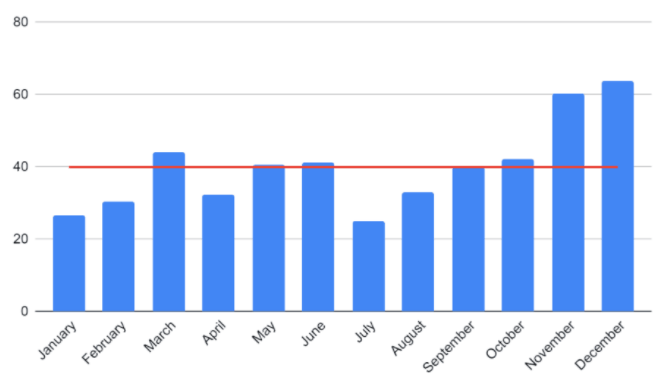Have you ever pondered why your ad RPMs vary throughout the year? This fluctuation can be a source of both wonder and annoyance for publishers. At times, you might notice a dip in ad revenue RPMs, only to see them hit record highs shortly after.
With September ushering in the end of summer, it’s crucial for publishers to anticipate the upcoming seasonal trends affecting ad revenue. Seasonality in advertising refers to how consumer events and industry trends influence advertiser spending and, consequently, ad revenue.
These fluctuations are primarily driven by changes in RPMs and website traffic, which correspond with various times of the year. These can be linked to cultural events (like Thanksgiving and Christmas), commercial holidays (such as Valentine’s Day and Mother’s Day), or significant occurrences (like the Olympics or election cycles).
Each Year Is Divided Into Different Seasons
The calendar year is segmented into quarters, each influencing advertising budgets:
- Q1: January through March
- Q2: April through June
- Q3: July through September
- Q4: October through December
Advertisers plan their budgets around these quarters, usually ramping up spending towards the end of each period. Specific events, like Amazon Prime Day or Black Friday, lead to noticeable spikes in ad spending and corresponding RPM boosts for publishers.
Seasonal Trends in Ad Revenue
After navigating through January, often the lowest point for RPMs, publishers typically see improvements in the subsequent months. However, fluctuations persist, influenced by quarterly budget cycles and specific events. July and January are commonly slower in terms of earnings, with the dynamics of fiscal year endings and major shopping periods (like December) playing a crucial role.
For instance, in Q1, advertising spend is generally conservative, following the exuberance of Q4’s holiday season. However, events like the Super Bowl or Valentine’s Day can uplift RPMs. The narrative is similar for Q2 and Q3, with various events and fiscal timelines influencing advertiser behavior.
Q4 stands out for its heightened advertising activity, aligning with significant shopping events and the year’s end budget expenditures, creating opportunities for publishers to maximize ad revenue.

Responding to Seasonal Trends In quieter months, it’s wise for publishers to undertake site improvements or alterations. Adjusting CPM floors or experimenting with ad sizes and placements can optimize earnings. Additionally, tailoring content to align with seasonal interests or events can enhance traffic and engagement.
Understanding these trends enables publishers to navigate the ebb and flow of ad revenue more effectively. Strategic planning around content and advertising can leverage high-spending periods, while the quieter months offer chances for optimization and preparation.
In the era of digital acceleration, underscored by shifts like increased online shopping during the pandemic, staying abreast of these trends and adapting strategies accordingly is more crucial than ever. For publishers looking to optimize their ad revenue throughout these seasonal shifts, seeking expert advice can be a valuable step. AdSight, for example, offers consultations to help publishers navigate and capitalize on these trends effectively.
